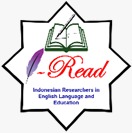Exploring the English Needs of Mechanical Engineering Students in ESP Class: Indonesian University Context
DOI:
https://doi.org/10.22219/englie.v1i1.13130Abstract
English for Specific Purposes in tertiary level puts its importance to Need Analysis (NA) process for syllabus design. This present research is concerned with designing ESP syllabus for Mechanical Engineering students in tertiary level through need analysis. The research aims to identify the immediate needs of the Mechanical Engineering students and design appropriated syllabus based on students’ needs using Target Situation Analysis (TSA) and Present Situation Analysis (PSA). In order to achieve the research’s objectives, a questionnaire was administered to a total 50 respondents. The finding of the research shows that among 4 basic English skills, listening skill emerged as the most important skill that students’ really need, followed by speaking, reading, and writing. Thus, this research suggests that ESP teachers should design more varied activities on listening course that students will have the competence to apply the skills later in future life context.
Downloads
References
Alsamadani, H. A. (2017). Needs Analysis in ESP Context: Saudi Engineering Students as a Case Study. Advances in Language and Literary Studies, 8(6), 58. https://doi.org/10.7575/aiac.alls.v.8n.6p.58
Ary, D., Jacobs, L. C., Sorensen, C., & Razavieh, A. (2010). Introduction to Research in Education. United States: Wadsworth Cengage Learning.
Boroujeni, S. A., & Fard, F. M. (2013). A Needs Analysis of English for Specific Purposes (ESP) Course For Adoption Of Communicative Language Teaching :( A Case of Iranian First-Year Students of Educational Administration). International Journal of Humanities and Social Science Invention ISSN, 2(6), 35–44. Retrieved from www.ijhssi.org
Goh, C. C. . (2013). ESP and Listening in Language Education and Assessment (D. Coniam, ed.). London: Springer.
Hossain, J. (2013). ESP Needs Analysis for Engineering Students: A Learner Centered Approach. Journal of Presidency University, 2(2), 16–26.
Izidi, R., & Zetouni, M. (2017). Esp Needs Analysis : The Case Of Mechanical Engineering Students At The University Of Sciences And Technology Oran U.S.T.O. Revue Des Études Humaines et Sociales, 16. https://doi.org/10.33858/0500-000-018-054
Kaur, S., & Khan, A. B. M. A. (2010). Language Needs Analysis of Art and Design Students: Considerations for ESP Course Design. ESP World, 9(2), 81–87. https://doi.org/10.1007/s13398-014-0173-7.2
Latief, M. A. (2017). Research Methods on Language Learning An Introduction, 6th Ed. Malang: Universitas Negeri Malang.
Li, J. (2014). Needs Analysis: An Effective Way in Business English Curriculum Design. Theory and Practice in Language Studies, 4(9), 1869–1874. https://doi.org/10.4304/tpls.4.9.1869-1874
McDonough, J. (2010). English for specific purposes: A survey review of current materials. ELT Journal, 64(4), 462–477. https://doi.org/10.1093/elt/ccq060
Mihalache, R. (2015). Motivation VS Need of ESP of Engineering Students. The Journal of International Social Research, 8(36), 968–979.
Poedjiastutie, D. (2017). The Pedagogical Challenges of English for Specific Purposes (ESP) Teaching at the University of Muhammadiyah Malang, Indonesia. Educational Research and Reviews, 12(6), 338–349. https://doi.org/10.5897/ERR2016.3125
Saragih, E. (2014). Designing ESP Materials for Nursing Students Based On Needs Analysis. International Journal of Linguistics, 6(4), 59. https://doi.org/10.5296/ijl.v6i4.5983
Vandergrift, L., & Goh, C. C. . (2012). Teaching and learning second language pragmatics. In Teaching and Learning Second Language Listening: Metacognition in Action. https://doi.org/10.4324/9781315716893
Williams, C. (2014). The future of ESP studies: building on success, exploring new paths, avoiding pitfalls. ASp, (66), 137–150. https://doi.org/10.4000/asp.4616
Downloads
Published
How to Cite
Issue
Section
License
Copyright (c) 2020 Akmal, A. N., Hidayati, N., & Farah, R. R.

This work is licensed under a Creative Commons Attribution-ShareAlike 4.0 International License.
Authors who publish with English Learning Innovation (englie) agree to the following terms:
- For all articles published in English Learning Innovation (englie), copyright is retained by the authors. Authors give permission to the publisher to announce the work with conditions. When the manuscript is accepted for publication, the authors agree to automatic transfer of the publishing right to the publisher.
- Authors retain copyright and grant the journal right of first publication with the work simultaneously licensed under a Creative Commons Attribution-ShareAlike 4.0 International License that allows others to share the work with an acknowledgement of the work's authorship and initial publication in this journal.
- Authors are able to enter into separate, additional contractual arrangements for the non-exclusive distribution of the journal's published version of the work (e.g., post it to an institutional repository or publish it in a book), with an acknowledgment of its initial publication in this journal.
- Authors are permitted and encouraged to post their work online (e.g., in institutional repositories or on their website) prior to and during the submission process, as it can lead to productive exchanges, as well as earlier and greater citation of published work (See The Effect of Open Access).
This work is licensed under a Creative Commons Attribution-ShareAlike 4.0 International License.

















1.png)












